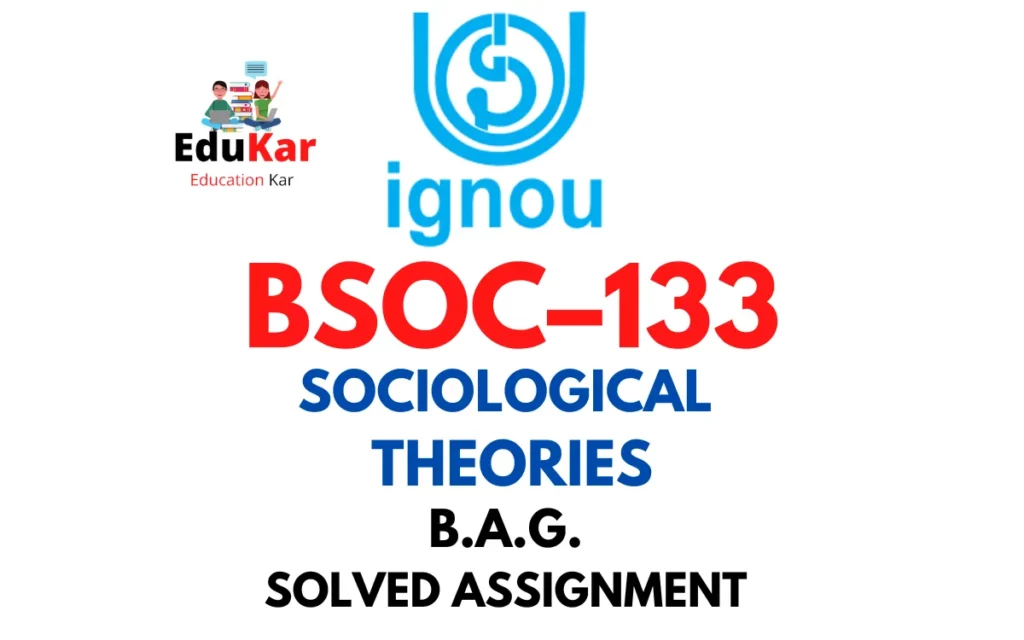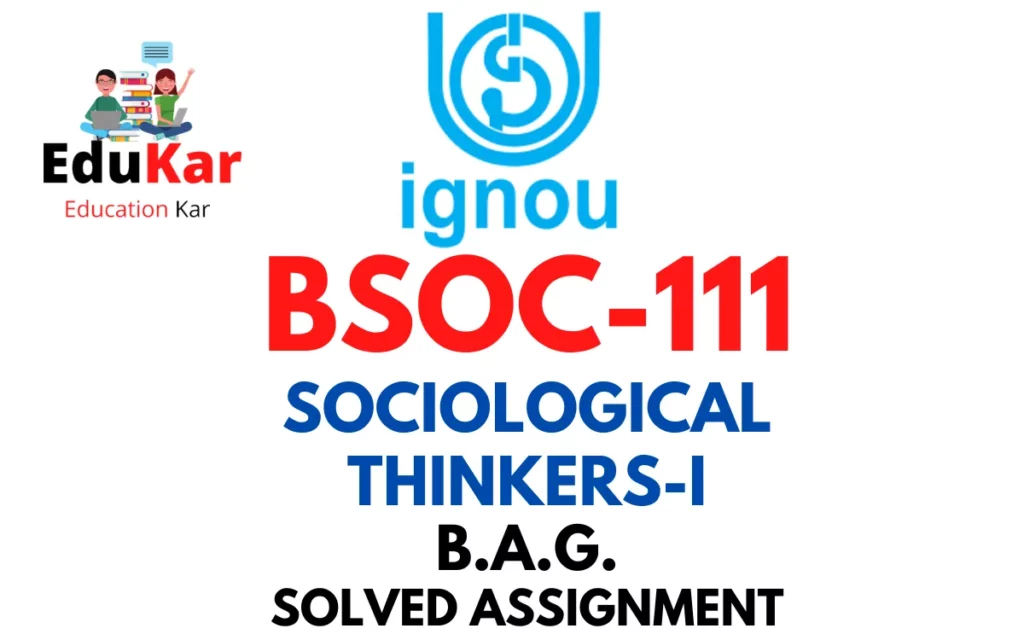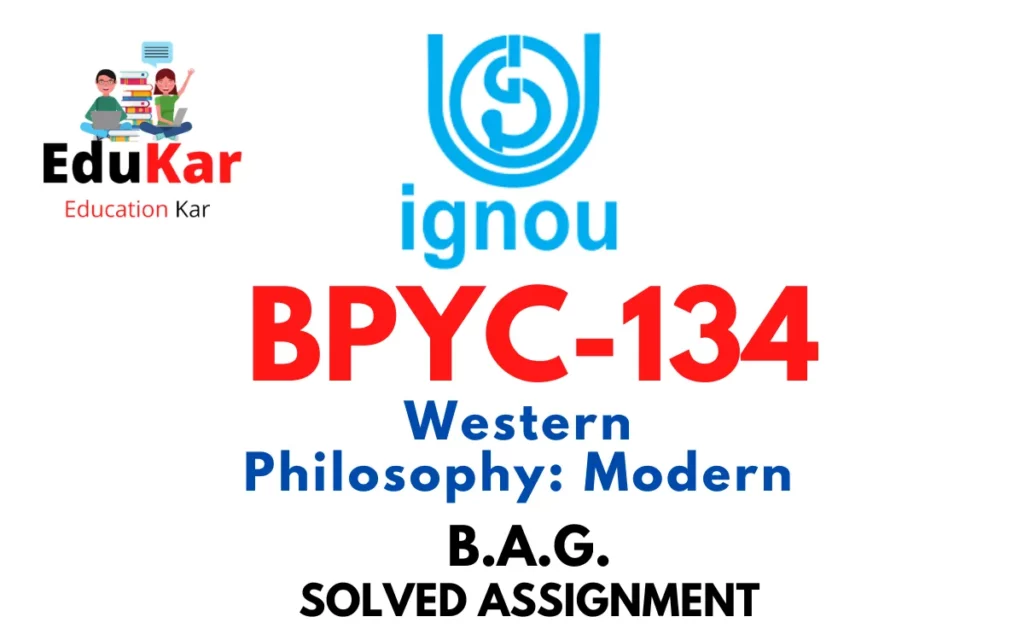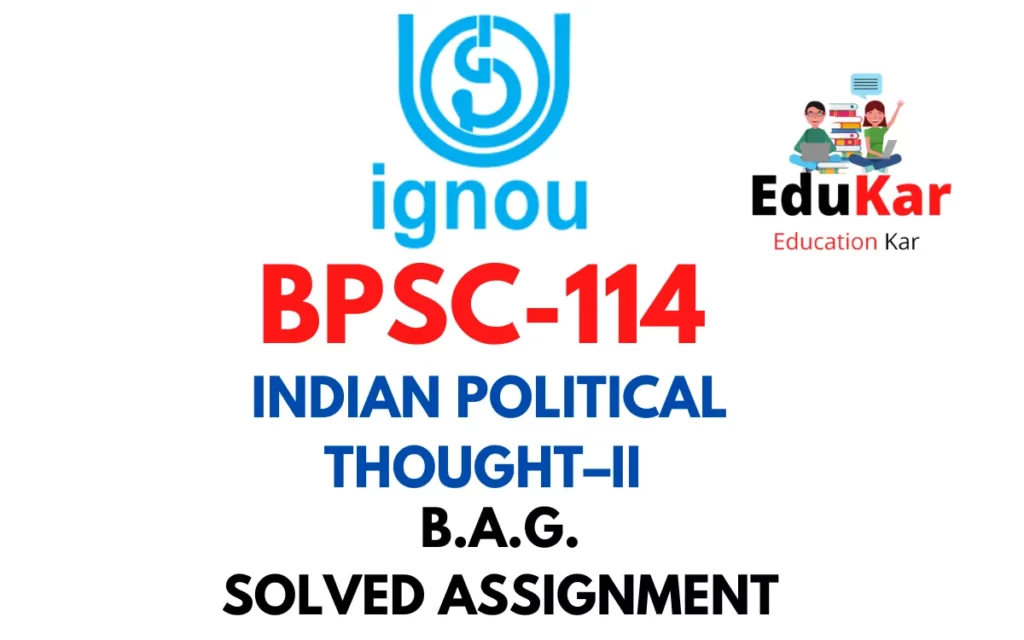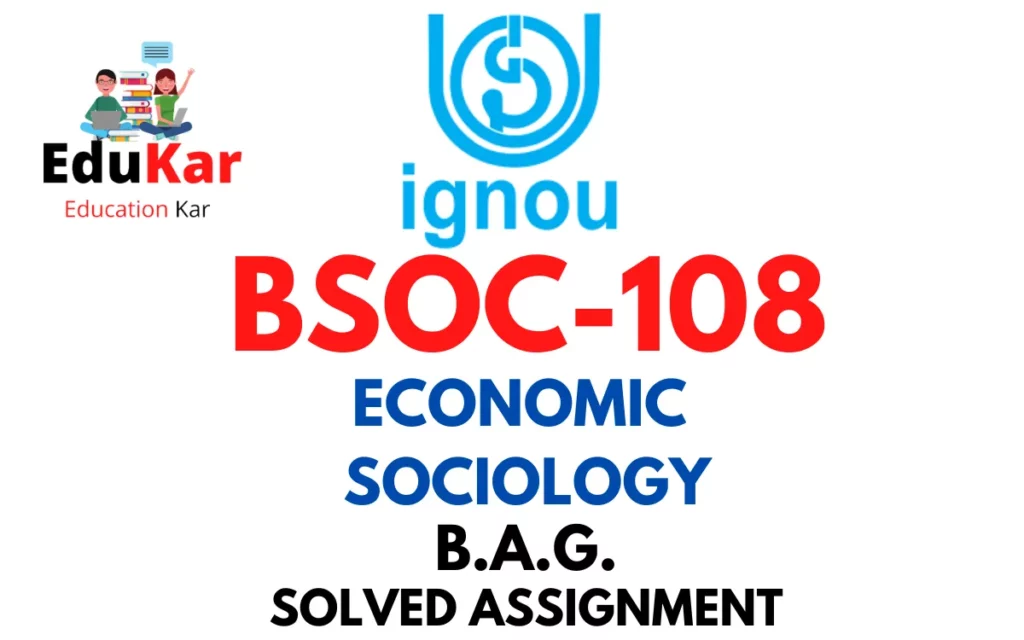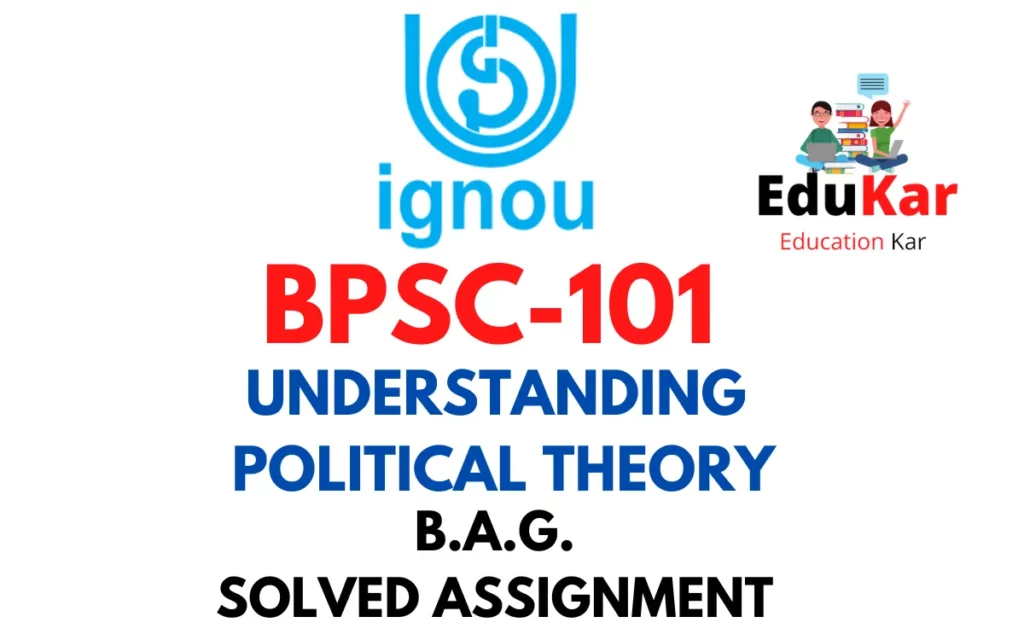Contents
- 1 Assignment – I
- 2 Answer the following in about 500 words each.
- 3 1. Analyse political theory and theory of revolution developed by Karl Marx.
- 4 2. Discuss the link between Christian missionaries, education and imperialism.
- 5 Assignment – II
- 6 Answer the following questions in about 250 words each.
- 7 3. Discuss the basic features of the Nazi regime.
- 8 4. Write a note on the crises in the Post-World War II capitalist Economy.
- 9 5. “Realism is a departure from idealism and emotion of Romanticism”. Explain.
- 10 Assignment – II
- 11 Answer the following questions in about 100 words each.
- 12 6. Explain the economic crisis of 1920s.
- 13 7. Analyse the rise of Fascism in Italy.
- 14 8. Write a note on Comintem.
- 15 9. Discuss in brief development of scientific knowledge.
- 16 10. Explain the development of the ideology of race.

| Title | BHIC-114: IGNOU BAG Solved Assignment 2022-2023 |
| University | IGNOU |
| Degree | Bachelor Degree Programme |
| Course Code | BHIC-114 |
| Course Name | HISTORY OF MODERN EUROPE -II (C. 1780 – 1939) |
| Programme Name | Bachelor of Arts (General) |
| Programme Code | BAG |
| Total Marks | 100 |
| Year | 2022-2023 |
| Language | English |
| Assignment Code | BHIC-114/ASST/TMA/2022-23 |
| Last Date for Submission of Assignment: | For June Examination: 31st April For December Examination: 30th September |
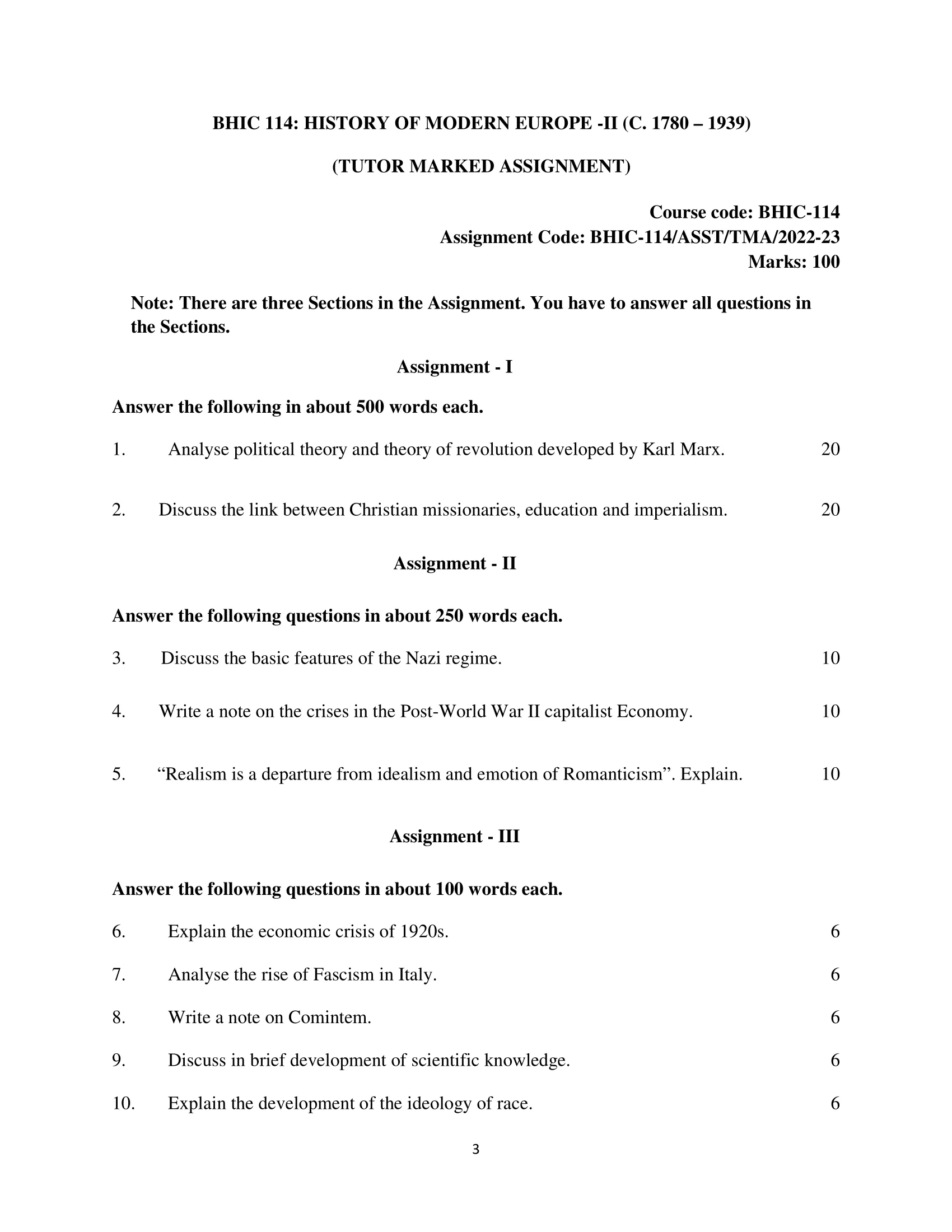
Assignment – I
Answer the following in about 500 words each.
1. Analyse political theory and theory of revolution developed by Karl Marx.
Ans: Karl Marx was a German philosopher, economist, sociologist, journalist, and revolutionary socialist. He is best known for his contributions to the theory of communism, which he called scientific socialism, and for his criticism of capitalism. Marx’s political theory was rooted in his materialist conception of history and his understanding of class struggle.
Marx’s materialist conception of history holds that economic and social conditions determine the course of history. According to Marx, society is divided into classes based on the ownership and control of the means of production (the land, factories, and other resources used to produce goods). In feudal societies, the ruling class was the aristocracy and the working class was composed of the serfs. In capitalist societies, the ruling class is composed of capitalists (the owners of the means of production) and the working class is composed of the workers.
Marx believed that class struggle was the driving force of historical change. He argued that the capitalists exploited the workers by paying them wages that were less than the value of their labor, and that the workers were thereby forced to sell their labor power in order to survive. This exploitation, according to Marx, was the source of the wealth of the capitalists and the poverty of the workers. He believed that the workers would eventually overthrow the capitalists in a revolution and establish a classless society in which the means of production would be owned and controlled collectively by the workers.
Marx’s theory of revolution was influenced by the ideas of the French Revolution, which he saw as a step forward in the development of human society. He believed that the revolution would be led by the working class, and that it would result in the establishment of a socialist state that would transition towards communism. He saw the state as a tool of the ruling class, and believed that it would wither away under communism, leaving a society without government.
Marx’s political theory was also influenced by his understanding of economics. He was critical of the capitalist system and believed that it was inherently unstable and would eventually collapse. He argued that the boom-and-bust cycles of the capitalist economy were a result of the exploitation of the workers and the unequal distribution of wealth. He believed that the working class would eventually rise up against the capitalists in a revolution and establish a socialist state that would transition towards communism.
Marx’s theory of revolution has been influential in the development of various political movements and has had a significant impact on the development of modern political thought. Despite this, his ideas have also been criticized for a number of reasons. Some have argued that his understanding of class struggle was overly simplistic, and that it did not take into account other factors that contribute to social and political change, such as race, gender, and culture. Others have criticized his prediction that the state would wither away under communism, arguing that this is unrealistic and that the state will always play a role in shaping society.
2. Discuss the link between Christian missionaries, education and imperialism.
Ans: The link between Christian missionaries, education and imperialism was a complex and multifaceted one, shaped by the intersection of religious, economic, and political interests. During the colonial period, Christian missions played a crucial role in spreading European values, beliefs, and cultural practices to the colonized peoples, often serving as instruments of imperialism. At the same time, they also provided education to the colonized, in the process shaping their understanding of the world and influencing their cultural and political identities.
In the context of imperialism, Christian missionaries saw education as a way to civilize the colonized and prepare them for eventual self-government. They believed that education was a necessary step in the process of converting people to Christianity and that it was essential for the development of the colonized societies. Through schools, missionaries aimed to inculcate Western values, beliefs, and cultural practices in the minds of the colonized, promoting cultural assimilation and shaping their understanding of the world in ways that reflected European perspectives.
At the same time, the spread of education by Christian missions also helped to further European economic and political interests. By providing education, the missions helped to create a class of educated people who could serve as intermediaries between the colonizers and the colonized, facilitating the administration and control of the colonies. Through education, the missions also helped to create a market for Western goods and services, as the educated class became more dependent on European trade and commerce.
However, while Christian missions played an important role in the spread of education and the consolidation of European control over the colonies, they were also subject to the larger forces of imperialism and were often used as instruments of colonial policy. Missions were often established in strategic locations, where they could exert the greatest influence over the colonized, and were often used to pacify and control rebellious populations. In this context, education was often seen as a means of pacification and social control, rather than as a tool for the development of the colonized societies.
Assignment – II
Answer the following questions in about 250 words each.
3. Discuss the basic features of the Nazi regime.
Ans: The Nazi regime, led by Chancellor and later Führer (leader) of Germany, Adolf Hitler, was a totalitarian dictatorship that existed from 1933 to 1945. The Nazi regime was characterized by several key features that had far-reaching consequences for Germany and the world.
First, the Nazi regime was characterized by a strong, central government. Hitler and his party, the National Socialist German Workers’ Party (Nazi Party), eliminated political opposition and established a single-party state. The Nazi regime controlled all aspects of German society, including the economy, media, education, and religion.
Second, the Nazi regime was characterized by racism and anti-Semitism. The Nazi Party believed in a pure German race and saw Jews, along with other minority groups such as Roma and homosexuals, as inferior. This ideology led to the extermination of approximately 6 million Jews in the Holocaust.
Third, the Nazi regime was characterized by aggressive expansionism and militarism. Hitler sought to create a greater Germany and build a powerful military. This led to the conquest of Austria and the Sudetenland in 1938, followed by the invasion of Poland in 1939, which led to the start of World War II.
Fourth, the Nazi regime was characterized by a cult of personality around Hitler. The Nazi Party controlled the media and used propaganda to present Hitler as a charismatic and heroic leader. The Nazi regime also used public events, such as rallies and parades, to demonstrate its power and mobilize support.
Finally, the Nazi regime was characterized by a highly organized and efficient bureaucracy. The Nazi Party created a vast network of organizations and agencies to carry out its policies, including the Gestapo (secret police), the SS (elite paramilitary organization), and the Nazi Party itself. These organizations were responsible for the implementation of the regime’s policies, including the Holocaust.
4. Write a note on the crises in the Post-World War II capitalist Economy.
Ans: The post-World War II capitalist economy has faced a number of crises, some of which have had significant impacts on the global economy. These crises can be broadly categorized into three main types: economic recessions, financial crises, and debt crises.
Economic recessions refer to periods of declining economic activity, characterized by decreased production, lower employment, and declining income. Some of the most notable economic recessions in the post-World War II period include the recessions of the early 1970s and early 1980s, as well as the 2008 global financial crisis.
Financial crises refer to disruptions in the financial system, such as bank runs, stock market crashes, and currency crises. One of the most notable financial crises of the post-World War II period was the 2008 global financial crisis, which was caused by a combination of factors including the collapse of the housing market, the overleveraging of financial institutions, and a global credit bubble.
Debt crises refer to situations in which countries are unable to meet their debt obligations, often as a result of economic recessions or financial crises. In the post-World War II period, there have been several debt crises in developing countries, including the Latin American debt crisis of the 1980s, the Asian financial crisis of the late 1990s, and the European sovereign debt crisis of the 2010s.
Each of these types of crises has had far-reaching consequences for the global economy, leading to increased economic instability, declining living standards, and increased inequality. Additionally, many of these crises have had long-lasting impacts, as they have contributed to changes in the structure of the global economy and altered the balance of power between different countries and regions.
5. “Realism is a departure from idealism and emotion of Romanticism”. Explain.
Ans: Realism was a cultural and artistic movement that emerged in the mid-19th century as a reaction against the idealism and emotion of Romanticism. Romanticism, which had dominated the preceding decades, emphasized personal feeling and intuition, often portraying emotional and imaginative experiences in a highly stylized and idealized manner. In contrast, Realism sought to represent the world in a more accurate and objective way, depicting the everyday experiences of ordinary people and focusing on the complexities of the social and political world.
In literature, Realism rejected the fantastical and imaginative elements of Romanticism, instead presenting stories that were rooted in the everyday lives of the characters and drawing from contemporary social and political issues. Realist writers sought to depict the world in a truthful and unsentimental way, focusing on the realistic details of characters, setting, and dialogue.
In art, Realism also rejected the idealized and emotional depictions of Romanticism, instead presenting images of the world as it truly was. Realist artists sought to capture the details and textures of everyday life, often depicting working-class subjects and contemporary social issues. Realist painters and sculptors often used a more naturalistic style, emphasizing the physical and emotional details of the people and objects they depicted.
Realism was not simply a reaction against Romanticism, but also a response to the profound social and political changes of the 19th century, including the rise of industrialization and the growth of cities. Realist artists and writers sought to reflect these changes by depicting the everyday experiences of the people who lived through them, and to challenge prevailing ideologies and values.
Assignment – II
Answer the following questions in about 100 words each.
6. Explain the economic crisis of 1920s.
Ans: The economic crisis of the 1920s, also known as the Great Depression, was a period of widespread economic hardship that lasted from 1929 to the late 1930s. It was characterized by a dramatic drop in industrial production, a sharp increase in unemployment, and a collapse in global trade. The crisis had its roots in the economic boom of the 1920s, which was fueled by an unsustainable increase in consumer debt, speculation in the stock market, and a decline in agricultural prices.
The crisis was triggered by the stock market crash of 1929, when the stock prices on the New York Stock Exchange plummeted, wiping out millions of dollars in investments. This led to a rapid decline in consumer spending and investment, which in turn resulted in widespread layoffs and a sharp contraction in economic activity.
The economic crisis was further exacerbated by the failure of many banks, which were unable to repay their depositors and had to be closed. This resulted in a loss of confidence in the banking system, which in turn led to a reduction in the money supply and further contraction in economic activity.
The crisis had far-reaching impacts, both domestically and globally. In the United States, the unemployment rate rose to over 25% and many businesses failed, leading to widespread poverty and hardship. The crisis also spread to other countries, particularly in Europe, where it was exacerbated by the impact of World War I and the debt burden that came with it.
Governments around the world struggled to respond to the crisis, with many adopting austerity measures that further reduced economic activity and increased hardship for their populations. It was not until the New Deal programs introduced by US President Franklin D. Roosevelt in the 1930s and the subsequent increase in government spending during World War II that the economy began to recover.
7. Analyse the rise of Fascism in Italy.
Ans: The rise of fascism in Italy can be traced back to the aftermath of World War I and the social, economic, and political turmoil that characterized the country in the years that followed. The war had left Italy with a weak and ineffective government, a struggling economy, and a disillusioned population. In this context, the fascist movement emerged as a radical alternative to the existing political order.
The fascist ideology, as espoused by its leader, Benito Mussolini, emphasized the importance of national unity, discipline, and order, and called for the creation of a strong, centralized state that would restore Italy to its former glory. The fascist movement was also characterized by a strong sense of nationalism and anti-communism, as well as by a rejection of liberal democracy and a commitment to authoritarianism.
In 1922, Mussolini and his followers staged a march on Rome, which resulted in the establishment of a fascist government and the consolidation of fascist rule over the country. Over the next several years, Mussolini and the fascist regime established control over the government, the media, and the military, suppressing political opposition and suppressing civil liberties.
The fascist regime in Italy was characterized by a cult of personality centered around Mussolini, as well as by aggressive expansionist policies, including the conquest of Ethiopia in 1936 and the alliance with Nazi Germany in the lead up to World War II. Despite initial military successes, however, the fascist regime was ultimately unable to sustain its power and influence, and was defeated in 1943, with Mussolini being executed in 1945.
8. Write a note on Comintem.
Ans: Comintem is an abbreviation of the Communist International, also known as the Third International. It was an international organization founded in 1919 with the goal of uniting the communist parties of the world and advancing the cause of socialism globally. The Comintem was established in the aftermath of the Russian Revolution and was based on the principles of the Bolshevik Party.
The Comintem played a significant role in shaping the course of the Communist movement during its existence. It provided a theoretical framework for Communist parties around the world and played a key role in coordinating their activities and efforts to achieve their goals. The Comintem also served as a source of guidance and support for Communist parties in their efforts to establish socialist regimes in their respective countries.
However, the Comintem was also a source of controversy and criticism, particularly with regard to its role in the purges and repression that took place in Soviet-controlled countries during the 1930s and 1940s. The Comintem was dissolved in 1943, following the signing of the Molotov-Ribbentrop Pact between the Soviet Union and Nazi Germany during World War II.
9. Discuss in brief development of scientific knowledge.
Ans: The development of scientific knowledge has been a long and continuous process, spanning thousands of years and involving the contributions of numerous scholars and researchers from around the world. This process has been characterized by the gradual accumulation of knowledge and understanding about the natural world, and by the development of new theories and discoveries that have advanced our understanding of the universe and our place in it.
One of the earliest examples of scientific knowledge can be traced back to ancient civilizations such as the Greeks and Romans, who made important contributions in fields such as mathematics, astronomy, and medicine. During the Renaissance, which took place in Europe from the 14th to the 17th centuries, scientific knowledge was advanced significantly with the works of great thinkers such as Galileo, who revolutionized our understanding of the universe, and William Harvey, who discovered the circulation of blood.
The Scientific Revolution, which took place in the 16th and 17th centuries, marked a significant turning point in the development of scientific knowledge, as scientists such as Isaac Newton and Robert Boyle developed new methods for scientific inquiry and experimentation, which allowed for the rapid advancement of scientific knowledge.
In the centuries that followed, science continued to evolve and expand, with important advances being made in fields such as physics, chemistry, biology, and medicine. In the 19th and 20th centuries, the discovery of new technologies, such as the microscope, the X-ray, and the computer, further expanded our ability to study and understand the natural world.
Today, scientific knowledge continues to grow and evolve, with new discoveries being made in fields such as genetics, computer science, and renewable energy, among others. The development of scientific knowledge has greatly influenced our understanding of the world around us and has had a profound impact on society, shaping the way we live and interact with the world.
10. Explain the development of the ideology of race.
Ans: The development of the ideology of race can be traced back to the early modern period, when European philosophers and scientists began to categorize human populations based on physical characteristics such as skin color, hair type, and facial features. This categorization was often driven by a desire to classify and rank different groups, and to justify colonialism and the exploitation of other populations. Over time, these categorizations became more rigid and were transformed into a set of beliefs about the innate superiority or inferiority of certain races, which were used to justify discrimination and oppression.
During the 19th and early 20th centuries, the ideology of race was further developed and codified in the fields of anthropology, biology, and psychology, as these disciplines sought to provide scientific foundations for the belief in racial differences. This resulted in the emergence of “scientific racism,” which was used to justify imperialism, slavery, and other forms of oppression.
Despite being discredited as a scientific concept, the ideology of race continues to shape political, economic, and social structures, and to influence attitudes and beliefs about race and racism. Today, the legacy of the ideology of race can be seen in the ongoing struggles for racial justice and equality, as people continue to resist and challenge the beliefs and practices that were shaped by this insidious and harmful ideology.
How to Download BHIC-114 Solved Assignment?
You can download it from the www.edukar.in, they have a big database for all the IGNOU solved assignments.
Is the BHIC-114 Solved Assignment Free?
Yes this is absolutely free to download the solved assignment from www.edukar.in
What is the last submission date for BHIC-114 Solved Assignment?
For June Examination: 31st April, For December Examination: 30th October



